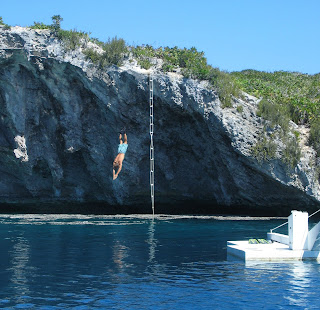When we were out and about in our rental van on 
Sunday, February 28, 2010
A Motto To Live By
Dean’s Blue Hole

Ragged Islands and Jumentos Cays
We spent nearly three weeks in the For a week we ping-ponged back and forth between two particular anchorages while fronts came through because one anchorage gave good protection from the south and west, while the other anchorage gave protection from the north, but we found time to anchor at some other beautiful spots like Buena Vista Cay (here's the beach on the cay’s western shore). The fishing here fantastic, and we ate some fish and lots of lobster (like this beauty in the pot). The folks on Side By Side, whom we met first at Hog Sty Reef and again at Flamingo and Water Cays, taught us that there’s lots of meat in the head and body of the large lobsters, so Chris has been patiently picking out the smaller yet abundant pieces of meat to use in casseroles or lobster omelets.
Tuesday, February 9, 2010
The Two That Got Away
Hog Sty Reef

Talk about the middle of nowhere. Hog Sty Reef is a barely submerged reef between
Thar Be Whales!
 Anne has been dying to see whales since we started cruising. No luck. However, the banks near the Turks and Caicos islands, about fifty miles south of Mayaguana, are wintering grounds for humpback whales, so we thought we might have a better chance around here. We set off one day for East Reef, at the eastern end of Mayaguana, keeping half an eye out for whales. And we saw them! The first sign was a disturbance on the surface about twenty feet from the boat, indicating that something large had recently sounded. Unfortunately, we missed them that close, but saw them about half a mile away. There were five or six, and they weren’t humpbacks, but they were definitely whales. Woo hoo!
Anne has been dying to see whales since we started cruising. No luck. However, the banks near the Turks and Caicos islands, about fifty miles south of Mayaguana, are wintering grounds for humpback whales, so we thought we might have a better chance around here. We set off one day for East Reef, at the eastern end of Mayaguana, keeping half an eye out for whales. And we saw them! The first sign was a disturbance on the surface about twenty feet from the boat, indicating that something large had recently sounded. Unfortunately, we missed them that close, but saw them about half a mile away. There were five or six, and they weren’t humpbacks, but they were definitely whales. Woo hoo!
Mayaguana

Mayaguana is a relatively large island north of the Turks and Caicos. We stayed in there about a week, first snorkeling and feasting on fish and lobster, then waiting out some weather.

